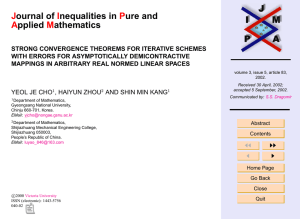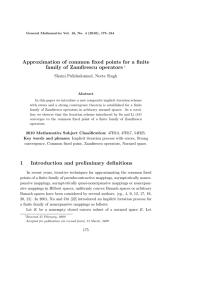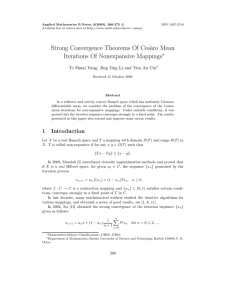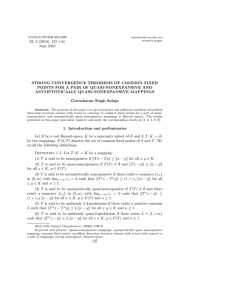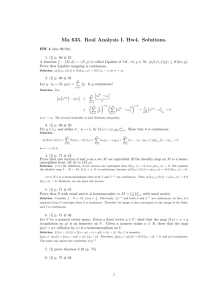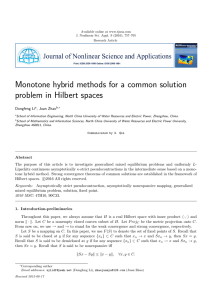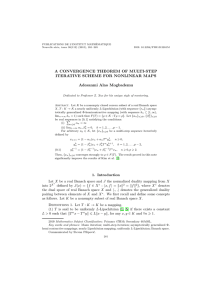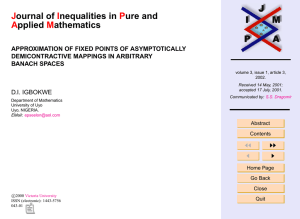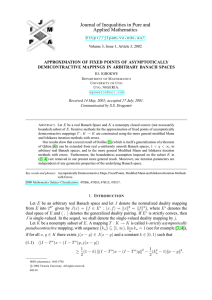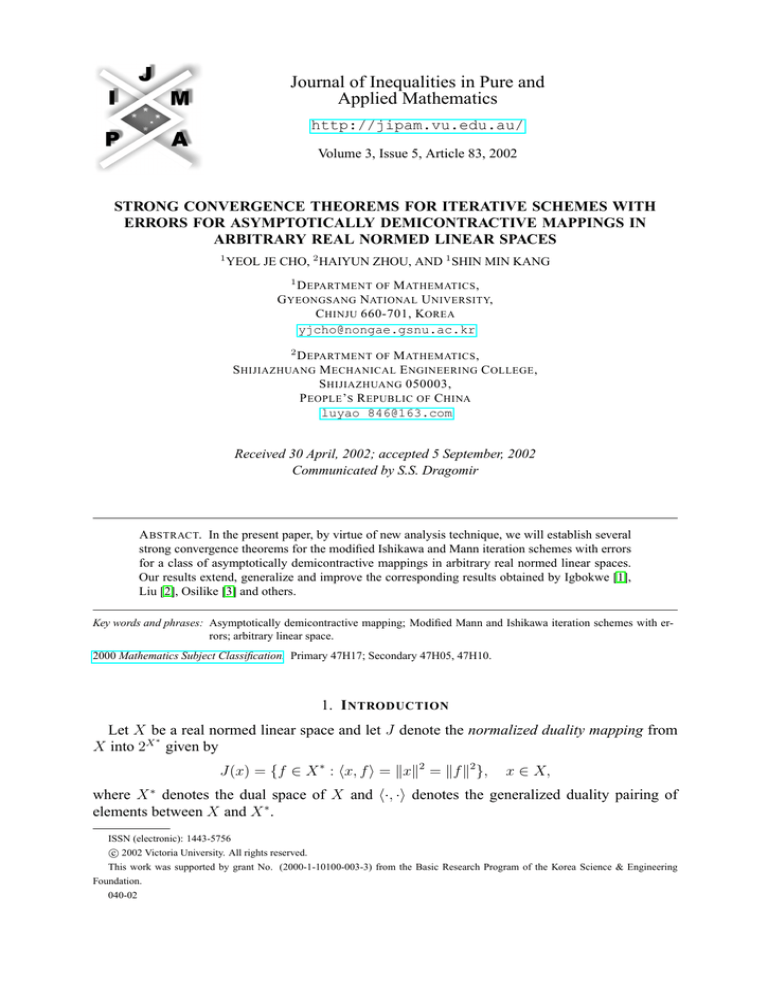
Journal of Inequalities in Pure and
Applied Mathematics
http://jipam.vu.edu.au/
Volume 3, Issue 5, Article 83, 2002
STRONG CONVERGENCE THEOREMS FOR ITERATIVE SCHEMES WITH
ERRORS FOR ASYMPTOTICALLY DEMICONTRACTIVE MAPPINGS IN
ARBITRARY REAL NORMED LINEAR SPACES
1
YEOL JE CHO, 2 HAIYUN ZHOU, AND 1 SHIN MIN KANG
1
D EPARTMENT OF M ATHEMATICS ,
G YEONGSANG NATIONAL U NIVERSITY,
C HINJU 660-701, KOREA
yjcho@nongae.gsnu.ac.kr
2
D EPARTMENT OF M ATHEMATICS ,
S HIJIAZHUANG M ECHANICAL E NGINEERING C OLLEGE ,
S HIJIAZHUANG 050003,
P EOPLE ’ S R EPUBLIC OF C HINA
luyao_846@163.com
Received 30 April, 2002; accepted 5 September, 2002
Communicated by S.S. Dragomir
A BSTRACT. In the present paper, by virtue of new analysis technique, we will establish several
strong convergence theorems for the modified Ishikawa and Mann iteration schemes with errors
for a class of asymptotically demicontractive mappings in arbitrary real normed linear spaces.
Our results extend, generalize and improve the corresponding results obtained by Igbokwe [1],
Liu [2], Osilike [3] and others.
Key words and phrases: Asymptotically demicontractive mapping; Modified Mann and Ishikawa iteration schemes with errors; arbitrary linear space.
2000 Mathematics Subject Classification. Primary 47H17; Secondary 47H05, 47H10.
1. I NTRODUCTION
Let X be a real normed linear space and let J denote the normalized duality mapping from
∗
X into 2X given by
J(x) = {f ∈ X ∗ : hx, f i = kxk2 = kf k2 },
x ∈ X,
where X ∗ denotes the dual space of X and h·, ·i denotes the generalized duality pairing of
elements between X and X ∗ .
ISSN (electronic): 1443-5756
c 2002 Victoria University. All rights reserved.
This work was supported by grant No. (2000-1-10100-003-3) from the Basic Research Program of the Korea Science & Engineering
Foundation.
040-02
2
Y EOL J E C HO , H AIYUN Z HOU ,
AND
S HIN M IN K ANG
Let F (T ) denote the set of all fixed points of a mapping T . Let C be a nonempty subset of
X.
A mapping T : C → C is said to be k-strictly asymptotically pseudocontractive with a
sequence {kn } ⊂ [0, ∞), kn ≥ 1 and kn → 1 as n → ∞ if there exists k ∈ [0, 1) such that
(1.1)
kT n x − T n yk2 ≤ kn2 kx − yk2 + k k(x − T n x) − (y − T n y)k2
for all n ≥ 1 and x, y ∈ C.
The mapping T is said to be asymptotically demicontractive with a sequence {kn } ⊂ [1, ∞)
and limn→∞ kn = 1 if F (T ) 6= ∅ and there exists k ∈ [0, 1) such that
(1.2)
kT n x − pk2 ≤ kn2 kx − pk2 + kkx − T n xk2
for all n ≥ 1, x ∈ C and p ∈ F (T ).
The classes of k-strictly asymptotically pseudocontractive and asymptotically demicontractive mappings, as a natural extension to the class of asymptotically non-expansive mappings,
were first introduced in Hilbert spaces by Liu [5] in 1996. By using the modified Mann iterates introduced by Schu [4, 5], he established several strong convergence results concerning
an iterative approximation to fixed points of k-strictly asymptotically pseudocontractive and
asymptotically demicontractive mappings in Hilbert spaces. In 1998, Osilike [3], by virtue of
normalized duality mapping, first extended the concepts of k-strictly asymptotically pseudocontractive and asymptotically demicontractive maps from Hilbert spaces to the much more general
Banach spaces, and then proved the corresponding convergence theorems which generalized the
results of Liu [2].
A mapping T : C → C is said to be k-strictly asymptotically pseudocontractive with a
sequence {kn } ⊂ [0, ∞), kn ≥ 1 and kn → 1 as n → ∞ if there exist k ∈ [0, 1) and
j(x − y) ∈ J(x − y) such that
(1.3)
h(I − T n )x − (I − T n )y, j(x − y)i
1
1
≥ (1 − k)k(I − T n )x − (I − T n )yk2 − (kn2 − 1)kx − yk2
2
2
for all n ≥ 1 and x, y ∈ C.
The mapping T is called an asymptotically demicontractive mapping with a sequence {kn } ⊂
[0, ∞), limn→∞ kn = 1 if F (T ) 6= ∅ and there exist k ∈ [0, 1) and j(x − y) ∈ J(x − y) such
that
(1.4)
1
1
hx − T n x, j(x − p)i ≥ (1 − k)kx − T n xk2 − (kn2 − 1)kx − pk2
2
2
for all n ≥ 1, x ∈ C and p ∈ F (T ).
Furthermore, T is said to be uniformly L-Lipschitzian if there is a constant L ≥ 1 such that
(1.5)
kT n x − T n yk ≤ Lkx − yk
for all x, y ∈ C and n ≥ 1.
Remark 1.1. The definitions above may be stated in the setting of a real normed linear space. In
the case of X being a Hilbert space, (1.1) and (1.2) are equivalent to (1.3) and (1.4), respectively.
Recall that there are two iterative schemes with errors which have been used extensively by
various authors.
J. Inequal. Pure and Appl. Math., 3(5) Art. 83, 2002
http://jipam.vu.edu.au/
S TRONG C ONVERGENCE T HEOREMS FOR I TERATIVE S CHEMES
3
Let X be a normed linear space, C be a nonempty convex subset of X and T : C → C be a
given mapping. Then the modified Ishikawa iteration scheme {xn } with errors is defined by
x1 ∈ C,
yn = (1 − βn )xn + βn T n (xn ) + vn ,
n ≥ 1,
x
n
n+1 = (1 − αn )xn + αn T (yn ) + un , n ≥ 1,
where {αn }, {βn } are some suitable sequences in [0, 1] and {un }, {vn } are two summable
sequences in X.
With X, C, {αn } and x1 as above, the modified Mann iteration scheme {xn } with errors is
defined by
x1 ∈ C,
(1.6)
xn+1 = (1 − αn )xn + αn T n (xn ) + un , n ≥ 1.
Let X, C and T be as in above. Let {an }, {bn }, {cn }, {a0n }, {b0n } and {c0n } be real sequences
in [0, 1] satisfying an + bn + cn = 1 = a0n + b0n + c0n and let {un } and {vn } be bounded
sequences in C. Define the modified Ishikawa iteration schemes {xn } with errors generated
from an arbitrary x1 ∈ C as follows:
yn = an xn + bn T n (xn ) + cn un , n ≥ 1,
(1.7)
x
0
0 n
0
n+1 = an xn + bn T yn + cn vn , n ≥ 1.
In particular, if we set bn = cn = 0 in (1.7), we obtain the modified Mann iteration scheme
{xn } with errors given by
x1 ∈ C,
(1.8)
x
0
0 n
0
n+1 = an xn + bn T xn + cn vn , n ≥ 1.
Osilike [3] proved the following convergence theorems for k-strictly asymptotically demicontractive mappings:
Theorem 1.2. [3] Let q > 1 and let E be a real q-uniformly smooth Banach space. Let K be a
nonempty closed convex and bounded subset of E and T : K → K be a completely continuous
and uniformly L-Lipschitzian asymptotically demicontractive
mapping with a sequence {kn } ⊂
P∞
2
[1, ∞) for all n ≥ 1, kn → 1 as n → ∞ and n=1 (kn − 1) < ∞. Let {αn } and {βn } be real
sequences in [0, 1] satisfying the conditions:
(i) P
0 < ≤ cq αn q−1 ≤ 21 {q(1 − k)(1 + L)−(q−2) } − for all n ≥ 1 and for some > 0,
(ii) ∞
n=1 βn < ∞.
Then the sequence {xn } defined by (1.6) with un ≡ 0 and vn ≡ 0 for all n ≥ 1 converges
strongly to a fixed point of T .
Very recently, Igbokwe [2] extended the above Theorem 1.2 to Banach spaces. More precisely, he proved the following results:
Theorem 1.3. [2] Let E be a real Banach space and K be a nonempty closed convex subset of
E. Let T : K → K be a completely continuous and uniformly L-Lipschitzian asymptotically
demicontractive
mapping with a sequence {kn } ⊂ [1, ∞) for all n ≥ 1, kn → 1 as n → ∞ and
P∞
2
(k
−
1)
<
∞. Let the sequence {xn } be defined by (1.7) with the restrictions that
n=1 n
(i) an + bn + cn = 1 = a0n + b0n + c0n ,
J. Inequal. Pure and Appl. Math., 3(5) Art. 83, 2002
http://jipam.vu.edu.au/
4
Y EOL J E C HO , H AIYUN Z HOU ,
AND
S HIN M IN K ANG
P
0
(ii) ∞
n=0 bn = ∞,
P∞
P
P∞
P∞
0
(iii) n=0 (b0 )2 < ∞, ∞
n=0 cn < ∞,
n=0 bn < ∞ and
n=0 cn < ∞.
Then the modified Ishikawa iteration {xn } defined by (1.6) and (1.7) converges strongly to a
fixed point p of T .
It is our purpose in this paper to extend and improve the above Theorem 1.3 from Banach
spaces to real normed linear spaces. In the case of Banach spaces, we use the Condition (A) to
replace the assumption that T is completely continuous.
In the sequel, we will need the following lemmas:
Lemma 1.4. Let X be a normed linear space and C be a nonempty convex subset of X. Let
T : C → C be a uniformly L-Lipschitzian mapping and the sequence {xn } be defined by (1.7).
Then we have
(1.9)
kT xn − xn k ≤ kT n xn − xn k + L(1 + L2 )kT n−1 xn−1 − xn−1 k
+ L(1 + L)c0n−1 kvn−1 − xn−1 k
+ L2 (1 + L)cn−1 kun−1 − xn k
+ Lc0n−1 kxn−1 − T n−1 xn−1 k,
n ≥ 1.
Proof. See Igbokwe [1, Lemma 1].
Lemma 1.5. Let X be a normed linear space and C be a nonempty convex subset of X. Let
T : C → C be a uniformly L-Lipschitzian
P∞ and asymptotically demicontractive mapping with a
sequence {kn } such that kn ≥ 1 and n=1 (kn − 1) < ∞. Let the sequence {xn } be defined by
(1.7) with the restrictions
∞
X
n=1
b0n
= ∞,
∞
X
2
(b0n )
< ∞,
n=1
∞
X
c0n
< ∞,
n=1
∞
X
cn < ∞.
n=1
Then we have the following conclusions:
(i) limn→∞ kxn − pk exists for any p ∈ F (T ).
(ii) limn→∞ d(xn , F (T )) exists.
(iii) lim inf n→∞ kxn − T xn k = 0.
Proof. It is very clear that (1.7) is equivalent to the following:
yn = (1 − bn )xn + bn T n (xn ) + cn (un − xn ), n ≥ 1,
(1.10)
xn+1 = (1 − b0n )xn + b0n T n yn + c0n (vn − xn ), n ≥ 1.
For any p ∈ F (T ), let M > 0 be such that
M = max{sup{kun − pk}, sup{kvn − pk}}.
Observe first that
(1.11)
kyn − pk ≤ (1 − bn )kxn − pk + bn Lkxn − pk + cn (M + kxn − pk)
≤ (1 + L)kxn − pk + M
and
(1.12)
kT n yn − xn k ≤ Lkyn − pk + kxn − pk
≤ L[(1 + L)kxn − pk + M ] + kxn − pk
≤ [1 + L(1 + L)]kxn − pk + M L.
J. Inequal. Pure and Appl. Math., 3(5) Art. 83, 2002
http://jipam.vu.edu.au/
S TRONG C ONVERGENCE T HEOREMS FOR I TERATIVE S CHEMES
5
Observe also that
kxn+1 − yn k ≤ kxn − yn k + b0n [kT n yn − pk + kyn − pk]
(1.13)
+ c0n [kvn − pk + kyn − pk]
≤ [bn (1 + L) + cn ]kxn − pk + (cn + c0n )M
+ [b0n (1 + L) + c0n ][(1 + L)kxn − pk + M ]
≤ σn kxn − pk + ςn ,
where
σn = [bn (1 + L) + cn ] + [b0n (1 + L) + c0n ](1 + L)
and
ςn = M [b0n (1 + L) + 2c0n + cn ].
Thus we have
kxn+1 − xn k ≤ b0n kT n yn − xn k + c0n (M + kxn − pk)
(1.14)
≤ b0n σn kxn − pk + ςn + c0n (M + kxn − pk).
Using iterates (1.10), we have
(1.15)
kxn+1 − pk2 ≤ kxn − pkkxn+1 − pk − b0n hxn − T n yn , j(xn+1 − p)i
+ c0n hvn − xn , j(xn+1 − p)ik
1
1
≤ kxn − pk2 + kxn+1 − pk2 − b0n hxn+1 − T n xn+1 , j(xn+1 − p)i
2
2
0
+ bn hxn+1 − xn + T n yn − T n xn+1 , j(xn+1 − p)i
+ c0n (M + kxn − pk)kxn+1 − pk,
which implies that
(1.16)
kxn+1 − pk2 ≤ kxn − pk2 − (1 − k)b0n kxn+1 − T n xn+1 k2
+ b0n (kn2 − 1)kxn+1 − pk2 + 2b0n (kxn+1 − xn k
+ kT n xn+1 − T n yn k)kxn+1 − pk
+ 2c0n (M + kxn − pk)kxn+1 − pk.
Substituting (1.12) – (1.14) in (1.16) and, after some calculations, we obtain
kxn+1 − pk2 ≤ (1 + γn )kxn − pk2 − (1 − k)b0n kxn+1 − T n xn+1 k2
P
for all very large n, where the sequence {γn } satisfies that ∞
n=1 γn < ∞. A direct induction
of (1.17) leads to
(1.17)
(1.18)
kxn+1 − pk2 ≤ kxn − pk2 + M γn − b0n kxn+1 − T n xn+1 k2 ,
which implies that limn→∞ kxn − pk exists by Tan and Xu [7, Lemma 1] and so this proves the
claim (i). The claim (ii) follows from (1.18).
Now, we prove the claim (iii). It follows from (1.18) that
∞
X
b0n kxn+1 − T n xn+1 k2 < ∞
n=1
and hence
lim inf kxn+1 − T n xn+1 k = 0
n→∞
P 0
since
b
=
∞.
Therefore,
we have lim inf n→∞ kxn − T n xn k = 0 by (1.7) and so
n n
lim inf n→∞ kxn − T xn k = 0 by Lemma 1.4. This completes the proof.
J. Inequal. Pure and Appl. Math., 3(5) Art. 83, 2002
http://jipam.vu.edu.au/
6
Y EOL J E C HO , H AIYUN Z HOU ,
AND
S HIN M IN K ANG
A mapping T : C → C with a nonempty fixed point set F (T ) in C will be said to satisfy the
Condition (A) on C if there is a nondecreasing function f : [0, ∞) → [0, ∞) with f (0) = 0
and f (r) > 0 for all r ∈ (0, ∞) such that
kx − T xk ≥ f (d(x, F (T )))
for all x ∈ C.
2. T HE M AIN R ESULTS
Now we prove the main results of this paper.
Theorem 2.1. Let X be a real normed linear space, C be a nonempty closed convex subset of
X and T : C → C be a completely continuous and uniformly L-LipschitzianPasymptotically
demicontractive mapping with a sequence {kn } ⊂ [1, ∞) such that kn ≥ 1 and ∞
n=1 (kn −1) <
∞. Let the sequence {xn } be defined by (1.7) with the restrictions
∞
X
b0n = ∞,
n=1
∞
X
2
b0n < ∞,
n=1
∞
X
c0n < ∞,
n=1
∞
X
cn < ∞.
n=1
Then {xn } converges strongly to a fixed point p of T .
Proof. It follows from Lemma 1.5 that
lim inf kxn − T xn k = 0.
n→∞
Since T is completely continuous, we see that there exists an infinite subsequence {xnk } such
that {xnk } converges strongly for some p ∈ C and T p = p. This shows that p ∈ F (T ).
However, limn→∞ kxn − pk exists for any p ∈ F (T ) and so we must have that the sequence
{xn } converges strongly to p. This completes the proof.
Theorem 2.2. Let X be a real Banach space, C be a nonempty closed convex subset of X and
T : C → C be a uniformly L-Lipschitzian and P
asymptotically demicontractive mapping with a
sequence {kn } ⊂ [1, ∞) such that kn ≥ 1 and ∞
n=1 (kn − 1) < ∞. Let the sequence {xn } be
defined by (1.7) with the restrictions
∞
X
n=1
b0n
= ∞,
∞
X
2
b0n
< ∞,
n=1
∞
X
c0n
< ∞,
n=1
∞
X
cn < ∞.
n=1
Suppose in addition that T satisfies the Condition (A), then the sequence {xn } converges
strongly to a fixed point p of T .
Proof. By Lemma 1.5, we see that
lim inf kxn − T xn k = 0.
n→∞
Since T satisfies the Condition (A), we have
lim inf f (d(xn , F (T ))) = 0
n→∞
and hence
lim inf d(xn , F (T )) = 0.
n→∞
By Lemma 1.5 (ii), we conclude that d(xn , F (T )) → 0 as n → ∞.
J. Inequal. Pure and Appl. Math., 3(5) Art. 83, 2002
http://jipam.vu.edu.au/
S TRONG C ONVERGENCE T HEOREMS FOR I TERATIVE S CHEMES
7
Now we can take an infinite subsequence
P∞ {xnj } of {xn } and a sequence {pj } ⊂ F (T ) such
−j
that kxnj − pj k ≤ 2 . Set M = exp { n=1 γn } and write nj+1 = nj + l for some l ≥ 1. Then
we have
(2.1)
kxnj+1 − pj k = kxnj +l − pj k
≤ [1 + γnj +l−1 ]kxnj +l−1 − pj k
( l−1
)
X
≤ exp
γnj +m kxnj − pj k
m=0
≤
M
.
2j
It follows from (2.1) that
2M + 1
.
2j+1
Hence {pj } is a Cauchy sequence. Assume that pj → p as j → ∞. Then p ∈ F (T ) since F (T )
is closed and this in turn implies that xj → p as j → ∞. This completes the proof.
kpj+1 − pj k ≤
Remark 2.3. We remark that, if T : C → C is completely continuous, then it must be demicompact (cf. [6]) and, if T is continuous and demicompact, it must satisfy the Condition (A)
(cf. [6]). In view of this observation, our Theorem 2.1 improves Theorem 1.3 in the following
aspects:
(i) X may be not a Banach space.
(ii) T may be not completely continuous.
(iii) Our proof methods are simpler than those of Igbokwe [1, Theorem 2].
As corollaries of Theorems 2.1 and 2.2, we have the following:
Corollary 2.4. Let X be a real normed linear space, C be a nonempty closed convex subset of
X and T : C → C be a completely continuous and uniformly L-LipschitzianPasymptotically
demicontractive mapping with a sequence {kn } ⊂ [0, ∞) such that kn ≥ 1 and ∞
n=1 (kn −1) <
∞. Let the sequence {xn } be defined by (1.8) with the restrictions
∞
X
b0n
= ∞,
n=1
∞
X
2
b0n
< ∞,
n=1
∞
X
c0n < ∞.
n=1
Then {xn } converges strongly to a fixed point p of T .
Proof. By taking bn , cn ≡ 0 for n ≥ 1 in Theorem 2.1, we can obtain the desired conclusion.
Corollary 2.5. Let X be a real Banch space, C be a nonempty closed convex subset of X and
T : C → C be a uniformly L-Lipschitzian asymptotically
demicontractive mapping with a
P∞
sequence {kn } ⊂ [0, ∞) such that kn ≥ 1 and n=1 (kn − 1) < ∞. Let the sequence {xn } be
defined by (1.8) with the restrictions
∞
X
b0n
= ∞,
n=1
∞
X
n=1
b2n
< ∞,
∞
X
c0n < ∞.
n=1
If T satisfies the Condition (A) on the sequence {xn }, then {xn } converges strongly to a fixed
point p of T .
Proof. It follows from Theorem 2.2 by taking bn , cn ≡ 0 for all n ≥ 1.
J. Inequal. Pure and Appl. Math., 3(5) Art. 83, 2002
http://jipam.vu.edu.au/
8
Y EOL J E C HO , H AIYUN Z HOU ,
AND
S HIN M IN K ANG
Remark 2.6. Using the same methods as in Lemma 1.5, Theorems 2.1 and 2.2, we can prove
several convergence results similar to Theorems 2.1 and 2.2 concerning on the modified Ishikawa
iteration schemes with errors defined by (1.6).
Remark 2.7. Igbokwe [1, Corollary 1] has shown that, if T : C → C is asymptotically pseudocontractive, then it must be uniformly L-Lipschitzian and hence our Theorems 2.1 and 2.2
hold for asymptotically pseudocontractive mappings with a nonempty fixed point set F (T ).
R EFERENCES
[1] D.I. IGBOKWE, Approximation of fixed points of asymptotically demicontractive mappings in
arbitrary Banach spaces, J. Ineq. Pure and Appl. Math., 3(1) (2002), Article 3. [ONLINE:
http://jipam.vu.edu.au/v3n1/043_01.html ]
[2] Q.H. LIU, Convergence theorems of sequence of iterates for asymptotically demicontractive and
hemicontractive mappings, Nonlinear Anal. Appl., 26 (1996), 1835–1842.
[3] M.O. OSILIKE, Iterative approximations of fixed points asymptotically demicontractive mappings,
Indian J. Pure Appl. Math., 29 (1998), 1291–1300.
[4] J. SCHU, Iterative construction of fixed points of asymptotically non-expansive mappings, J. Math.
Anal.Appl., 158 (1991), 407–413.
[5] J. SCHU, Weak and strong convergence of fixed points of asymptotically non-expansive mappings,
Bull. Austral. Math. Soc., 43 (1991), 153–159.
[6] H.F. SENTER AND W.G. DOTSON, JR., Approximating fixed points of non-expansive mappings,
Proc. Amer. Math. Soc., 44 (1974), 375–380.
[7] K.K. TAN AND H.K. XU, Fixed point iteration processes for asymptotically non-expansive mappings, Proc. Amer. Math. Soc., 122 (1994), 733–739.
J. Inequal. Pure and Appl. Math., 3(5) Art. 83, 2002
http://jipam.vu.edu.au/

